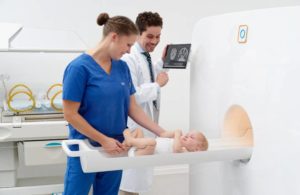
Neoscan Solutions last week unveiled a small, light MRI scanner designed to keep journeys short and to scan sick babies in their sleep.
Grosshansdorf, Germany-based Neoscan’s lightweight scanner deviates from the current MRI scanners, which weigh around eight tons and need to be located on floors that can bear such weight, while also requiring more space and support equipment along with liquid helium supercooling, which needs special handling, according to a news release.
Neoscan’s smaller design uses digitizers and AWGs (arbitrary waveform generators) from Spectrum Instrumentation that offer sub-nano-second coherence precision to generate the scanner signals and capture results.
The team at Neoscan developed a dry magnet to create a standard 1.5 Tesla field inside the scanner that doesn’t require liquid helium, which was done by an inner, cylindrical magnet generating 2.5 Tesla and an outer cylindrical magnet that counteracts the inner field.
Current MRI scanners require three large racks of specifically developed electronics that the manufacturer custom designed and built, but Neoscan uses a PC with software created by the company, plus high-end measurement PC cards from Spectrum Instrumentation.
Neoscan said it will be installing its first devices in German hospitals so prospective customers can observe the system as it scans babies, while the process for obtaining CE mark approval is ongoing and expected to conclude by the end of 2021.
“Having worked with MRI scanners for many years, I recognized the problem,” Neoscan founder Stefan Roell said in the release. “Scanning a sick child usually means a long journey out of the ward to the scanner and babies may need support equipment that is not easily transportable. Because of this, sometimes an MRI scan is not even done. We have designed an MRI scanner specifically for newborns and infants which means that the hole in the middle is only 30cm in diameter, not 60cm. As a result, the scanner is much smaller (170cm x 150cm x 110cm) and can go through standard doorways.
“With a weight of only 2000 kg, it can be located on standard floors and, needing only ten square meters, it can be installed in a spare room directly on the children’s ward. Carrying a sleeping baby only a few meters to the MRI is a big advantage, saving a long journey through the building and the need for sedatives to keep the baby motionless for the scan.”